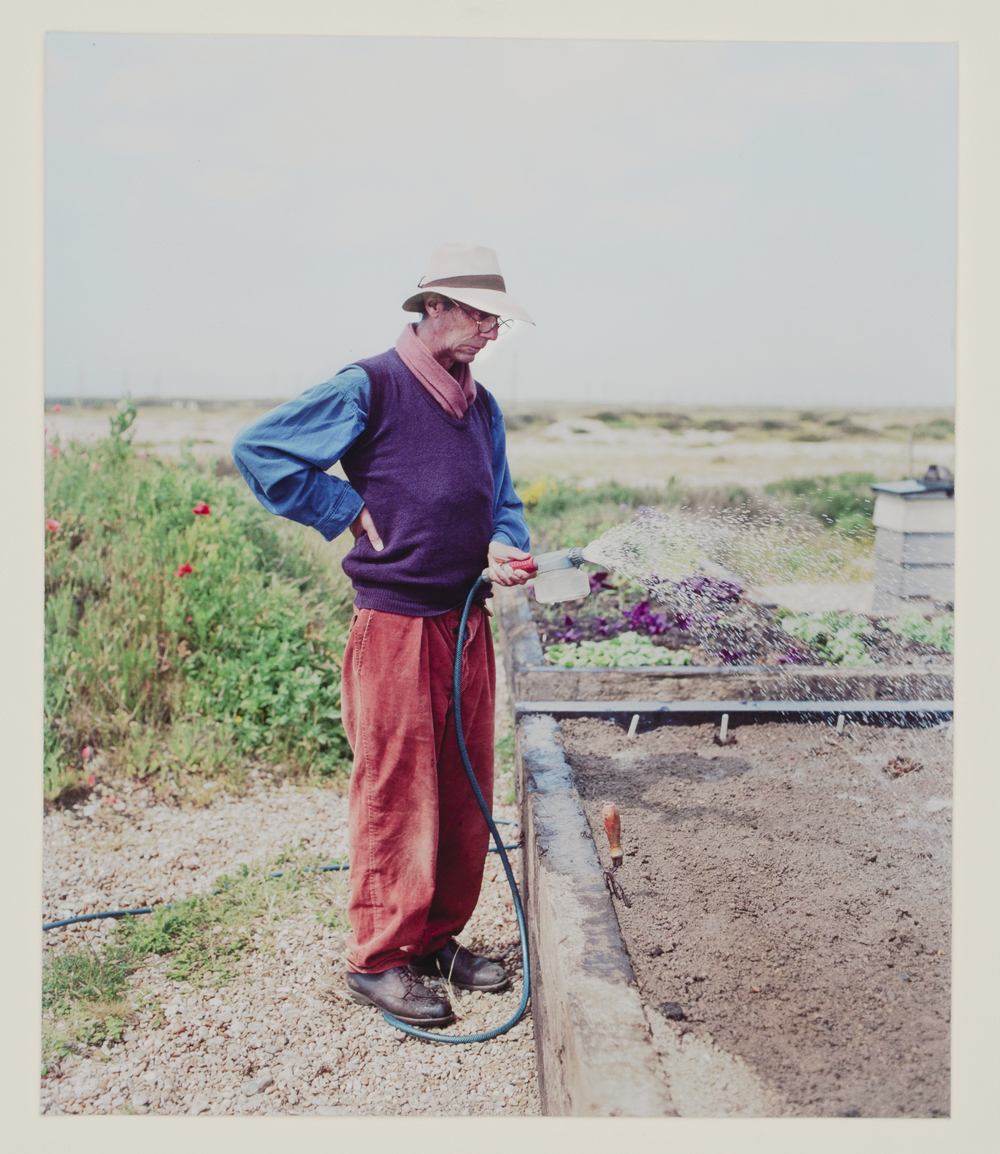Braving the elements, but enjoying the lack of crowds, Graham Hooper guides through a couple of nature-inspired exhibitions
IMAGE LEFT: Prospect Cottage c.1990 © Howard Sooley
It’s a very quiet day in the Capital to review exhibitions – for the first time since the Covid-19 lockdown began. Quiet, not just because the tourists seemed to be tentative about planning any visits, but also surely because the weather is tempestuous. Gusty winds batter me as I walk along the Southbank towards Vauxhall, trying to prevent my umbrella from turning inside out. I get drenched from the squally downpours in the short walk from the tube station to The Garden Museum, but the venue is redemptive. Hardly hidden, but equally hardly known, the Garden Museum is housed in an old church, adjacent to Lambeth Palace, and sited on the Thames bank. Modern glass frontage reveals the Sackler garden just beyond the entrance café area – a small, semi-exotic courtyard with seating. But I am here to experience Derek Jarman’s garden, or at least a reconstruction of his Dungeness hideaway, “Prospect Cottage”. Jarman maybe as ‘niche’ as the Garden Museum, known only to aficionados who have enjoyed and respected his creative output over many years, He died of AIDS-related illness, aged just 54, in 1994. Wikipedia describes him as “an English film director, stage designer, diarist, artist, gardener, and author”, but underground art scene dwellers will surely be familiar with his eclectic output, the sheer daringness of his vision and the scope of his knowledge; he made films about English Monarchs, Austrian Philosophers and Italian painters, all of them as innovative as they are captivating.
The Garden Museum has chosen a poignant time to celebrate his garden and home for the last years of his life, as it was recently bought for the public after the Art Fund raised over £3.5 million in its largest crowdfunding campaign to date.
I wasn’t prepared for the delights and delicacies on show at this marvellous, secret celebration of all-things-garden. Before even entering the main exhibition space I took time to enjoy the photographs of Jarman’s garden, taken in 1990 by Howard Sooley. A series of 8 or 10 A4 images, displayed at eye level, in a neat row, provide the perfect introduction. They combine gentle observations of objects collected from the shingle shore of Dungeness, carefully arranged by Jarman, with views of his black-and-yellow cottage and shots of Jarman himself interacting with flora and objects. Most interesting for me was how well these poignant recordings worked so well both in black and white, and in colour. Rendered in grey scale, we focus on the contrasts of line and texture – hard, black curves set against the soft, mossy backdrop of mist and sky, often with delicate narrow focus. But the vibrancy of the colour schemes is striking; the violet lavender and the rich sea kale, the deep red-orange poppies and spiked lime thistle. Always in the background the cottage, geometric wooden angles, and cornflower-yellow edges, set amongst the shingle of the beach.
For two hours I was transported – utterly – away from the drenched streets of the capital to the Kent coast.
On entering the main converted church space, I was struck by two large canvases, perhaps each six-feet-square, with impasto oil of blue or green, and displaying the words ACID RAIN and OH ZONE. Jarman was very good with words, as his numerous diary entries on show here attest. He wrote with eloquence and insight about all manner of subjects. Though these monumental paintings are minimal in their choice of displayed text, they are all the more powerful for their restraint, coupled with the vigorous, almost frenzied application of pigment in the upper half of the square surface. In his journals, many pages of which are available here to be savoured, the words are gorgeous in their sensuality and freedom. One letter written to Beth Chatto, the British plants-woman, known for her extensive knowledge of plants that thrive under specific circumstances (such as the salty, arid Dungeness estate), he outlines his extensive inventory of plants native to his locale. The handwritten fountain pen contours are velvet black and Shakespearean-looking. Jarman had won a number of gardening competitions whilst still at school. Here we see the gardening book that sparked his imagination. At the age of four, no less, his parents had given him an illustrated manual, “Beautiful Flowers and How To Grow Them”, from 1926. How strange and touching, that a young boy should take to a pastime that must have seemed beyond his age in many ways. At school he had a small plot to tend and copied the drawings. Weeding with his grandmother whilst on family holidays were some of his earliest memories. But this show, for all its tenderness, isn’t in the slightest bit sentimental. Instead, it is informative and practical.

Anyone who has ever visited Dungeness – home to a nuclear power station, a lighthouse, a miniature gauge railway and WWII pre-radar concrete sonic dishes, as well as a large shingle beach, often referred to as the UK’s only desert – will be familiar with its eerie persona. The estate is littered with eccentric ex-fisherman’s buildings. The highlight here is the replica of Prospect Cottage. Time has evidently been taken to re-create not just the frontage, and interiors but the quality of light (clear and fresh). The floor is covered in the shingle; his writing desk, tools and books are all in-situ. Excerpts of his Super 8 film, “The Garden” are playing (I sat transfixed). For two hours I was transported – utterly – away from the drenched streets of the capital to the Kent coast. It was miraculous.
I haven’t even mentioned the other treats in store, often sadly under-advertised. The sunken font, the tower (affording spectacular views across the Thames), and some of the most bizarre, genuinely fascinating displays (of garden gnomes, watering cans, pesticides…). And the less garden-specific; whale spine vertebrae, collection of exotic shells and a plaster cast of a dodo head.
Somerset House is a very pleasant thirty-minute walk along the South Bank to Westminster Bridge. Damp conditions, I am told, are ideal conditions for fungi (mushrooms and toadstools – you’ll need to ‘Google’ the difference). Knowing what I do now about just how important and extraordinary this particular type of organic form is, I’m delighted to hear that. Finding two exhibitions that connect so well was pleasing enough, but to have them situated in such proximity too. Somerset House courtyard was also unseasonably quiet, which meant I could sit out (under an umbrella) and take in the stunning classical architecture, the fountains and the river, before entering “Mushrooms: The Art, Design and Future of Fungi”.
Room after room explained with charm and dynamism how fungi underpin all life on earth; how they inform thinking in economics (Cryprocurrency!) and the practical sciences, how they provide practical solutions in food (not just bread and cheese) and medicine (Penicillin of course), and how they have penetrated the hearts and minds of creatives throughout history.
Who knew that the oldest and largest living organism in the world is a fungus, growing in Oregon, USA, measuring over 200 acres in size and somewhere between 2,400 and 8,650 years old?! How could I have known that there are somewhere between 2 and 4 million fungal species on the planet, ninety-three per cent of which are still uncatalogued? To learn that fungi are closer to animals than plants, when studied at the level of DNA, was mind-boggling.
So it was in light of these kinds of statistics that I looked at the specimens. They are no longer the object of disgust and horror, nor the symbol of decay, poison and witchcraft they once were. Indeed, I note that some high street supermarkets are selling dried Shiitake mushrooms at £8 for 100g. Sub-Saharan Cave paintings from 10,000 years ago document the use of psycho-active mushrooms in shamanistic rituals. I couldn’t help thinking that ALL mushrooms are magic!
There is only time and space here to pick out some highlights. On show is a selection of (more than 300 surviving) watercolour studies by Beatrix Potter and the obligatory illustrations from “Alice in Wonderland” by the likes of Sir John Tenniel. They are as subtle and charismatic as you’d imagine.

Filling a whole wall, sadly some examples too high up to really scrutinise, was Simon Popper’s “Mycology Philately”. Hundreds of stamps from around the world, featuring pictures of fungi, all carefully catalogued and labelled. It’s an undertaking that he’s spent the last decade and a half working on. Why? I’m not sure. But they’re beautiful and again, enchanting. I find stamps – so much more than just small and functional objects – inherently attractive, and to see un-marked collections like this, would be enough for a whole exhibition of their own. The variety of shapes and styles was a joyous surprise. Excerpts of John Cage’s “Mushroom Book” and Cy Twombly’s print series, “Natural History” are a rare sighting to savour. Cage, best known for his ‘silent’ musical composition 4’33” was an avid mycologist, and even sold his foraging to local New York restaurants.
Both Somerset House and the Garden Museum should be congratulated, not least given the current situation, to provide experiences and create environments that cultural institutions are so good at doing: growing inspiration and harvesting creativity.
DEREK JARMAN: MY GARDEN’S BOUNDARIES ARE THE HORIZON – at the Garden Museum, to 13 December 2020 gardenmuseum.org.uk
Mushrooms: The Art, Design and Future of Fungi at Somerset House www.somersethouse.org.uk




No Comments
No comments yet.
Sorry, the comment form is closed at this time.